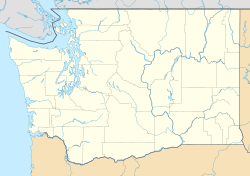Ceres, Washington facts for kids
Quick facts for kids
Ceres, Washington
|
|
|---|---|
|
Former community, locale
|
|
| Country | United States |
| State | Washington |
| County | Lewis |
| Elevation | 240 ft (73 m) |
| Time zone | UTC-8 (Pacific (PST)) |
| • Summer (DST) | UTC-7 (PDT) |
| ZIP code |
98532
|
| Area code(s) | 360 |
Ceres, also called Ceres Hill, was once a small farming and train stop community in Lewis County, Washington. Today, it's known as a specific location. You can find it near the Chehalis River, right off Washington State Route 6. The Willapa Hills Trail, a popular path, goes right through where Ceres used to be.
History of Ceres
Ceres started as a train stop called Long's Crossing for the Northern Pacific Railroad. A general store soon opened near the station. The railroad later named the community "Ceres" after Ceres, the Roman goddess of farming. This name was chosen because the soil in the area was very good for growing crops. By the late 1890s, the train stop was known as Ceres station. The first Ceres Bridge was built around the year 1900.
In the 1890s, Ceres became a place for logging. A special dam called a splash dam was built in 1897 to help move logs. However, a big flood later that year destroyed the dam. A steamboat named the "Carrie Davis" also operated from Ceres. It carried people and goods to the Skookumchuck River.
Growth and Changes
Ceres continued to grow in the early 1900s. A new grocery store opened in August 1908. The post office was set up inside this store in October of the same year. Telephone lines were installed in 1911, which made residents very happy. Logging continued in the area into the late 1910s, with a logging camp operating there.
Ceres was most active in the 1920s. Residents formed the Ceres Improvement Club, which even had its own meeting hall. The area was known as a farming district with a small population. By the 1930s, people often called it "Ceres Hill." By the 1960s, it was mostly referred to as just an "area" rather than a town. After major floods in 2007, reports mentioned damage in the Ceres Hill Road area, but no longer referred to Ceres as a community.
Ceres Post Office
The Ceres post office opened in 1908 inside the new grocery store. It stayed open until 1931. At first, it used simple mailboxes. By the 1920s, the Ceres postmaster managed a mail route that delivered mail three days a week. This route went to nearby towns like Boistfort, Doty, Dryad, and even as far west as Pe Ell. People could sign up to have their mail delivered on this route.
By 1930, the mail route was stopped. Residents had to pick up their mail in Chehalis. The Ceres postmaster quit at the end of that year. Attempts were made to hire a new postmaster, and the route was briefly restarted. However, no one wanted the job permanently because the pay was too low. The Ceres post office officially closed on May 29, 1931.
Geography
Ceres is located about 12 miles (19 km) west of Chehalis. The area is famous for its rich, fertile soil, which was great for farming. In the early days, the region where Ceres is located was known as King's prairie.
Education
Ceres had a school as early as 1900. Students from the state juvenile detention center, Green Hill School, even held a musical performance there. By 1910, Ceres had two school districts, numbered 67 and 138. School No. 67 later joined with No. 138 in 1917. The school never had many students; in 1918, there were only 15 pupils. The school closed before the 1936-1937 school year. A new road built by the Public Works Administration allowed Ceres students to travel to the nearby town of Klaber, Washington.
Economy
The Ceres region was well-known for its farming and agriculture. Farmers in Ceres grew a lot of hops, a plant used in brewing. One farmer even won an award for his hops at a show in New York City. Ceres was also famous for its high-quality Holstein cows. In 1933, cows from Ceres even set a world record for the number of calves born!



